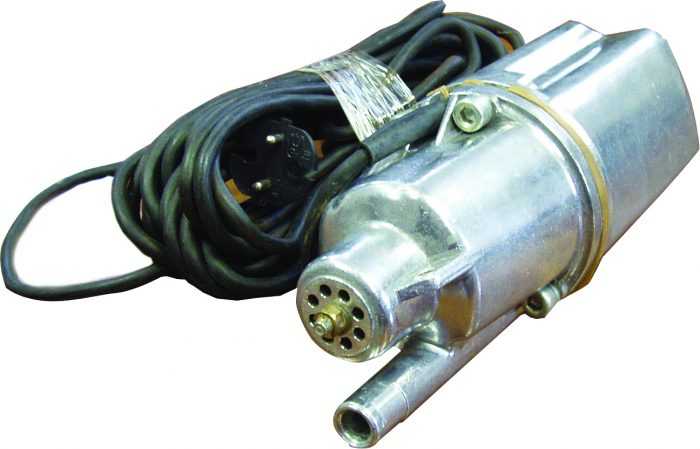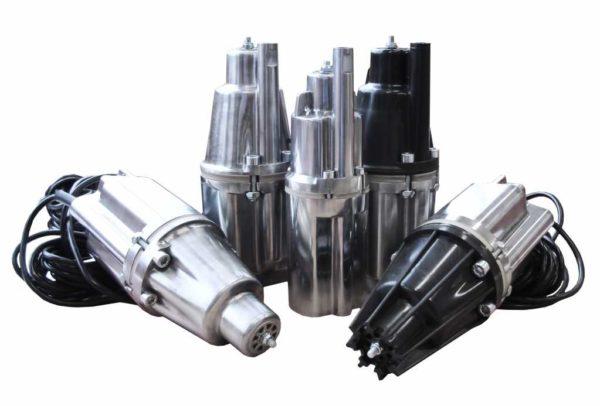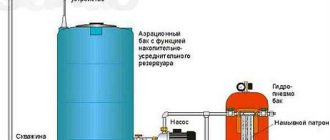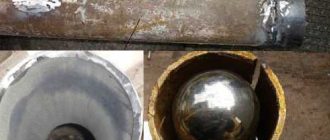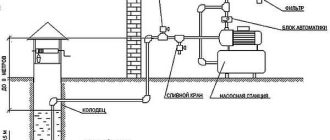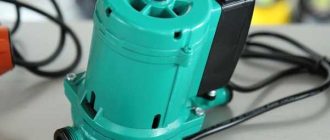A submersible pump Malysh can do all this, whether watering a vegetable garden, pumping water into a tank from a well, river, lake or even from a well. What’s nice, it costs very little, true and has modest characteristics, but for watering the vegetable garden or providing water to a couple of faucets it will be enough.
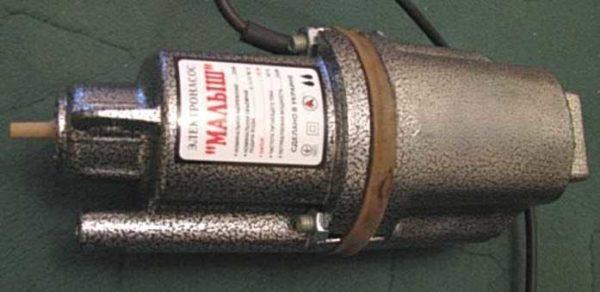
Contenuto dell'articolo
Field of application
Submersible pump Malysh has a low price, suitable for pumping clean water. Strongly contaminated water it is better not to pump it – it will quickly burn. It is used in the following cases:
- for watering the vegetable garden;
- for pumping water into storage tanks;
- for water supply at home, but with certain restrictions (about this below).
Pump water submersible pump Malysh can pump water from a well, a natural source – pond, river, lake. It is suitable for distributing water from containers. It can also be used for wells, but with reservations. Since the pump type is vibrating, it creates vibrations in the water column, lifting the smallest particles (silt, clay, sand) from the bottom and sucking them up. If in the case of a well it is nothing but opaque water does not threaten, then when using the pump Malysh in the well it can quickly silt up. In any case, this is the popular opinion.
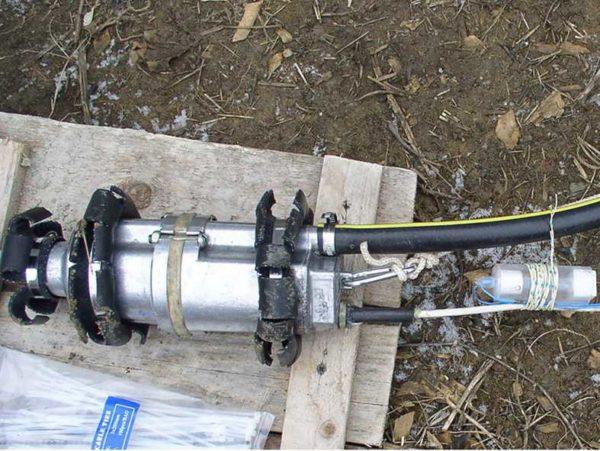
Manufacturers in the recommendations for use indicate the minimum diameter of the well or borehole – 90-100 cm, some models (Malysh 3) can work in sources with a diameter of 70-75 cm. Nevertheless, they are also used in very narrow wells. The main thing is that it should go there. But at the same time it beats against the walls of the well, creating additional vibration and threatening to crack the casing or damage its own casing. To reduce runout, rubber rings are put on the casing (pictured above). They solve the problem.
Produttori
The name “Malysh” and “Rucheek” has long become a nominal name. So today they call small submersible vibrating pumps. Initially, they were produced exclusively in Russia or in the near abroad, but today there are plenty of Chinese “Malysh” on the market. In general, there are several manufacturers of such pumps in Russia:
- In the city of Livny in the Orel region and in Bavleny in the Vladimir region produce exactly Malyshy. Most of them have an upper water intake, Malyshi M – with a lower one.
- Malyshi are also produced in Klimovsk, Moscow region.
- Kursk and Kirov (Lepse plant) produce pumps of the same type, but under other names – Vodolei.
- In Bryansk (enterprise Topol) produce Rodnichki. With the same name produce submersible pumps in Chelyabinsk, as well as the firm Zubr.
- Units Ruchek produce in Mogilev (Belarus).
The other brands are Chinese. How to determine? Carefully consider the packaging and passport. If it is a Russian manufacturer, there must be an address, the name of the company, a list of services, etc. If there is no such information, this product comes from the DPRK.
Technical characteristics
As already said, submersible pumps Malysh have a small capacity – mostly about 250 watts, that is, it is not able to create high pressure. Their clones with other names can be found a little more powerful.
What else is important – the lifting height – this is how far water can be pumped.In the technical specifications, it should be greater than the one you need by about 20%.
Pay attention to the power supply that the model is designed for. Usually it is 200 V with possible small deviations of about 5%, but the reality is that the network may be 240 V, and at this voltage, the pump with these characteristics will burn. The way out is to put a stabilizer or look for a model with a higher operating voltage (lowering from the working voltage is not so adversely affect the work – the power is reduced).
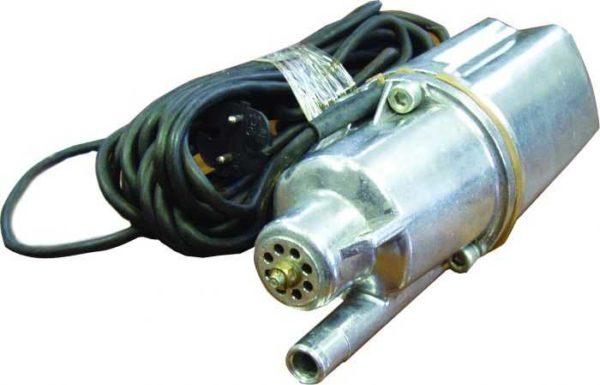
Another important indicator is productivity. It is usually indicated in liters per minute or per second. This value shows how much water the unit is able to pump under normal conditions. For this type of equipment, this figure is quite small – about 400 ml / sec. Such a submersible pump Baby can provide water to one point of watering – one irrigation hose or a faucet in the house. It is not capable of anything more without additional equipment.
| Nome | Water intake | Protection against idling / overheating | Power | Performance | Lifting height | Diameter | Immersion depth | Prezzo |
|---|---|---|---|---|---|---|---|---|
| Malysh-M P 1500 Topol | Upper | no/yes | 240 W | 24 l/min | 60 м | 99 mm | 3 м | 1741 rubles (plastic) |
| Rucheyok-1 Mogilev | Upper | no/no | 225 W | 18 l/min | 72 м | 110 mm | 1459 rubles (10 m cord) | |
| PATRIOT VP-10B (USA/China) | Top | no/no | 250 W | 18 l/min | 60 м | 98 м | 7 м | 1760 rubles (cable length 10 m) |
| BELAMOS BV012 (Russia/China) | Lower | no/no | 300 W | 16.6 l/min | 70 м | 100 mm | 3 м | 2110 rubles (10 m cord) |
| Malysh-M 1514 Topol | Upper | no/yes | 250 W | 25 l/min | 60 м | 98 mm | 3 м | 2771 rubles (metal, 40 m cord) |
| Kalibr NVT-210/10 (Russia/China) | Upper | no/no | 210 W | 12 l/min | 40 м | 78 м | 10 м | 1099 rubles (10 m cord) |
| Zubr MASTER Rodnichok NPV-240-10 | Upper | no/no | 240 W | 24 l/min | 60 м | 100 м | 3 м | 1869 rubles (10 m cord) |
| QUATTRO ELEMENTI Acquatico 250 | Upper | no/no | 250 W | 17.5 l/min | 75 м | 100 м | 2 м | 2715 rubles (10 m cord) |
| Aquarius-3 (Lepse) | Upper | no/yes | 265 W | 26 l/min | 40 м | 98 mm | 1900 rubles (10 m cord) | |
| Malysh 25 m (Kursk) | Nizhny | yes/no | 250 W | 7.1 l/min | 40 м | 1920 rubles (25 m cord) |
Each variety of pumps is presented with a different length of the electric cord and the price varies (the longer the cord, the more expensive). You can also find varieties with dry run protection, but you can make it yourself (see below).
Installation in a well or borehole
The submersible pump Malysh is suspended on a synthetic cable. Metal rope or wire quickly deteriorate from vibration. Their use is possible if a synthetic rope is tied at the bottom – at least 2 meters. To secure it, there are lugs in the upper part of the housing. The end of the rope is threaded through them and carefully fastened. The knot is located no lower than 10 cm from the pump casing – so that it is not sucked inside. The cut edges are melted to prevent the cable from unraveling.
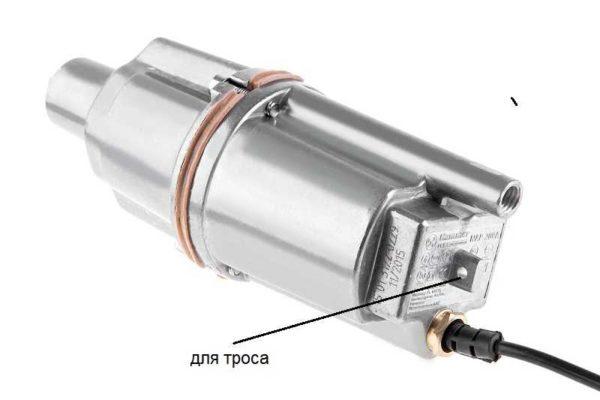
Connecting hoses and pipes
The supply hose is attached to the pump outlet. Its inner diameter should be slightly smaller (by a couple of millimeters) than the socket diameter. A hose that is too narrow creates an additional load, which causes the unit to burn out more quickly.
Flexible rubber or polymer hoses, as well as plastic or metal pipes of a suitable diameter can be used. If pipes are used, the pump is connected to them with a piece of flexible hose at least 2 meters long.
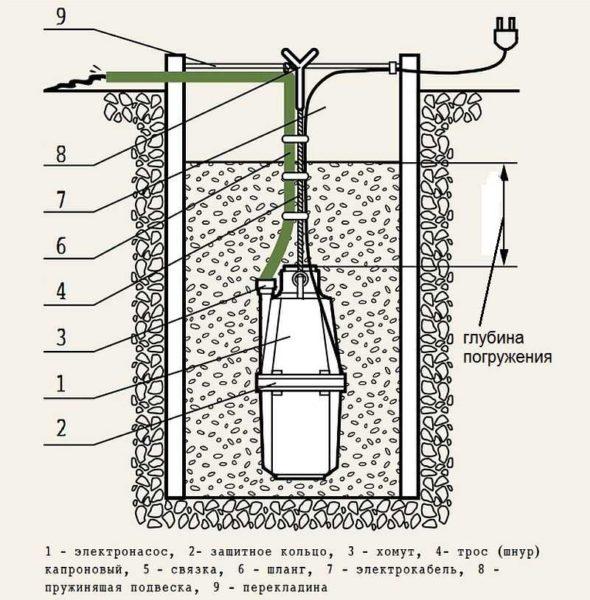
The hose on the pipe is fixed with a metal clamp. Usually there is a problem here: the hose slips off due to constant vibrations. To prevent this from happening, the outer surface of the socket can be filed to give it an extra roughness. You can also grind a groove under the clamp, but do not get too carried away. It is better to use a clamp made of stainless steel with notches – it gives additional rigidity to the fastening.
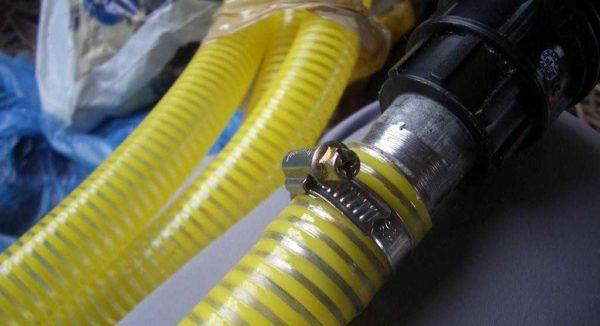
Preparation and descent
Installed hose, cable and electric cable are pulled together by installing ties. The first one is placed at a distance of 25-30 cm from the body, all the others with a step of 1-2 meters. Ties can be made of adhesive tape, plastic clamps, pieces of synthetic twine, etc. The use of metal wire or clamps is prohibited – they rub the sheaths of the cord, hose or the twine itself when vibrating.
On the head of the well or well, a crossbar is installed, for which the rope will be attached. The second option is a hook on the side wall.
The prepared pump is carefully lowered to the required depth. Here, too, questions arise: at what depth to install a submersible pump Malysh. The answer is twofold. First, the distance from the water mirror to the top of the housing should be no more than the depth of immersion of this model. For “Malysh” firm Topol it is 3 meters, for the unit PATRIOT – 10 meters. Secondly, the bottom of the well or borehole should be at least one meter away. This is in order not to disturb the water too much.
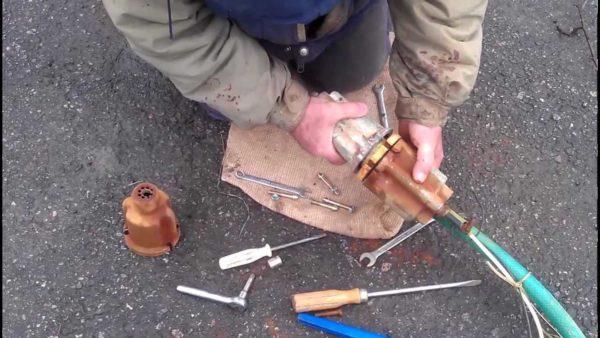
If the submersible pump Baby is installed in a well, it should not touch the walls. When installed in a well, a rubber spring ring is put on the casing.
Having lowered the pump to the required depth, the cable is fixed on the bar. Please note: the entire weight must be on the rope, not on the hose or the cable. For this purpose, the twine is tightened and the cord and hose are loosened slightly when fastening.
Installation in a shallow well
At a shallow depth of the well, when the length of the cable is less than 5 meters, to neutralize vibrations, the cable is suspended from the bar through a springy gasket. The best option is a piece of thick rubber that can withstand the load (weight and vibration). The use of springs is undesirable.
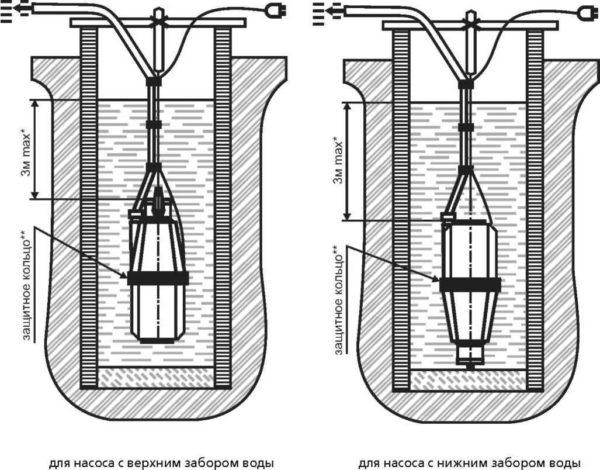
Installation in a river, pond, lake (horizontally)
The submersible pump Malysh can be operated horizontally. Its preparation is similar – put on the hose, fasten everything with ties. Only then the casing should be wrapped with a rubber sheet 1-3 mm thick.
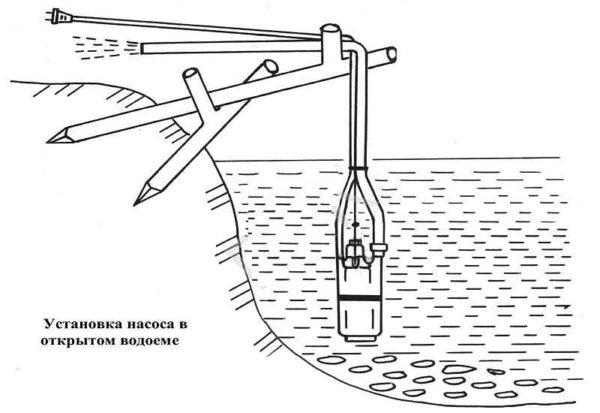
After the pump is lowered under water, it can be turned on and operated. It does not require any additional measures (priming and lubrication). It is cooled down by pumped water, which is why switching on without water is extremely bad for it: the motor overheats and can burn out.
Peculiarities of operation
In some models of submersible vibrating pumps for wells there is protection against overheating. This is a very useful function that prevents the motor from burning out. With prolonged operation or violations of operating conditions, the built-in thermorelay (overheat protection) opens the power circuit, turning off the pump. After a short time, the relay resets and operation resumes.
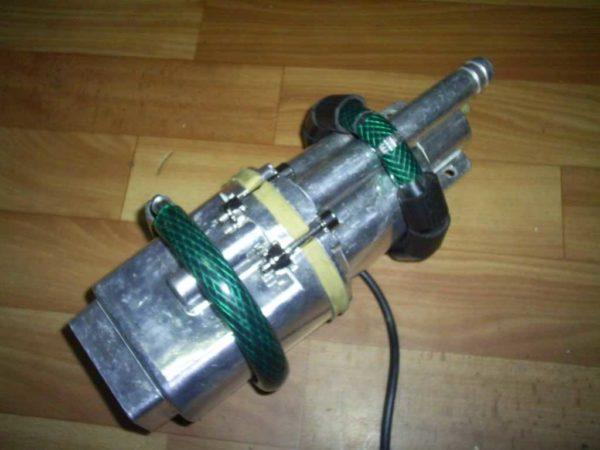
If your pump has shut down due to overheating, it is advisable to find out the cause immediately. Disconnection can be caused by a lack of water, high voltage. If so, you should start the equipment only when everything comes back to normal. Another possible cause is a clogged suction pipe. This can only be dealt with by taking the pump out, disassembling and cleaning it, which is contraindicated during the warranty period. Although, if you have a clogged pump, you have already violated the rules of operation – it is suitable for pumping only clean water.
Protection against dry running
Since many models of the Little can not be lowered below three meters from the water mirror, at low flow rate there is a threat that the water will run out, and the pump will continue to work and as a result will burn out. To avoid this situation you can install a water level sensor. This is a float sensor, which is also called a “frog”. It works very simply:
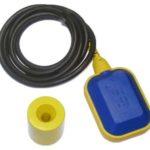
- when it is up, the contacts are closed and power is supplied;
- when the water level drops, the float also drops, the contacts in the sensor open, breaking the power supply circuit;
- water is gradually gaining, the float rises higher, at a certain level the contacts are closed again, the pump is switched on.
The cost of such a sensor – less than 1 t.r., is installed simply – in the break of the power cable, but its usefulness is great.
Working with a hydraulic accumulator
In general, vibrating submersible pumps are not designed to work in conjunction with a hydroaccumulator. They cannot create high enough pressure. But… under certain conditions, they work. The assembly scheme is standard: pump, pressure switch, pressure gauge, hydraulic accumulator, all this is assembled through a five-wire connection. For normal operation, a check valve is installed at the end of the hose submerged in water (so that the water does not flow back into the well). Another condition – the hydroaccumulator should be of significant capacity (100 or 150 liters).
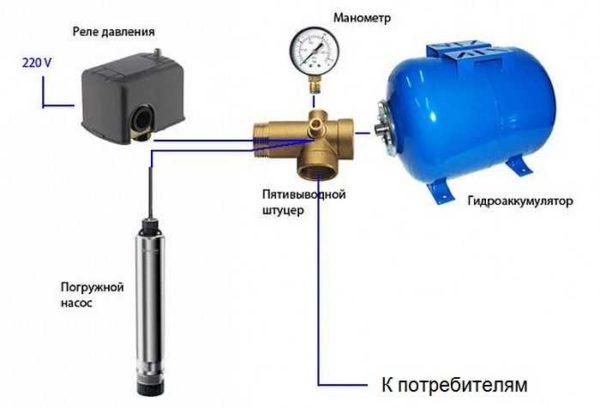
Having assembled this scheme is required to adjust the pressure switch. It is set the less, the better, otherwise the Malysh will not have enough power. But even with a small pressure, everything will work for a couple of years, but more likely – a year and a half.
What to do to work longer
Pumps of the Malysh type cost very little, but also serve for a short time – about 2-3 years. In their production, inexpensive materials are used – to reduce the cost of production. If you take some measures immediately after purchase, as well as regular “maintenance inspections”, you can significantly extend the service life. So, what can be done:
- The screws that fasten the body immediately replace them with longer ones, supplement them with lock nuts. If this is not done, the screws loosen and break the stem.
- Inspect the pump once a month, disassemble and flush it when pumping dirty water.
- When operating with a hydraulic accumulator, set the minimum pressure.
- Install dry run protection.
- Supply voltage via a stabilizer.
Some of the measures are costly. For example, the stabilizer costs about the same or even more than this pump, but it can be used with other types, and all of them will work better with a stable voltage. But changing the bolts is the key thing that needs to be done.

